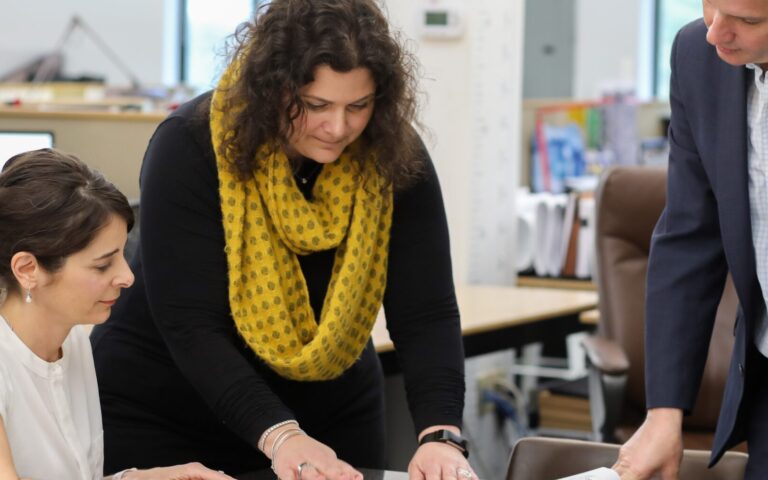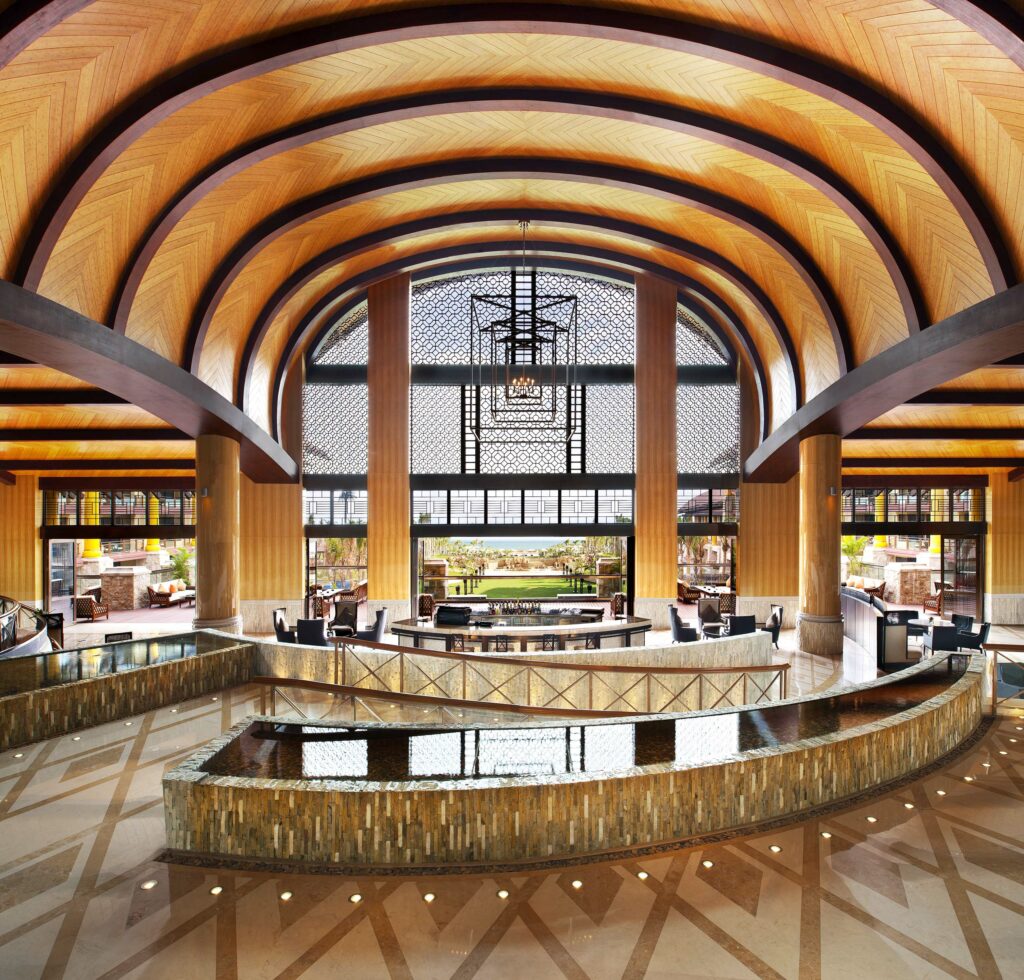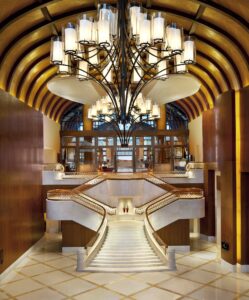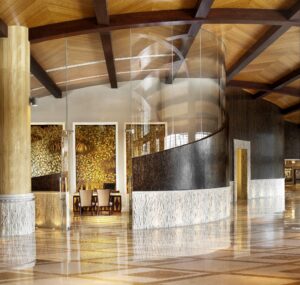
The Hotel Lobby
Jennifer Skaife, Design Director at DiLeonardo
March 3, 2012
You arrive in it, you leave via it, you meet friends and colleagues there, you linger there, or alternatively hurriedly pass through it; so what is the Hotel Lobby, anyway?
You register, you way find, seeking direction to successfully navigate the next stage of your stay in the hotel, you encounter a whole list experiences throughout it and of all the public areas you probably remember it – or alternatively find it as forgettable as any space in the Hotel, and yet what is it really?

The St Regis Sanya, China
Is it simply a ‘public’ space, a hallway, a passageway, an exaggerated corridor, a waiting room, a hub, a necessary place on the way to your inner sanctum, your private space – your room, or is it a social venue, a bar, a restaurant, a lounge, a nightclub, a breakfast diner, a brunch café, a business center, an extension of home, or home as you would love it to be? We now find ourselves being asked to respond to an operational program that includes some, if not all of the former. This mostly, but not always interior, space is now asked to function as all of these some of the time, and by definition is unquestionably asked to function as some of these all of the time. It is the ubiquitous, Hotel Lobby.
Over the recent past couple of decades we have seen many iterations, variations, and interpretations of our design briefs, and program demands, from owners and operators alike, and as designers we have contributed to the same but as I recall it was sometime in the 1980’s when the current trend in which we still find ourselves participating, for Hotel lobbies being something more than circulation, registration and the hub for vertical transportation really started – again. If we look to the grand hotels of the late 19th Century – they certainly offered as much if not more complexity and variety to the guest experience, with lounges and cafes, terraces, often with vast themed, public spaces, offering a clear identity, luxury and sense of place, lavishly furnished and activated by the new affluent upper middle classes, those engaging in the “Grand Tour” in Europe, and in North America exploring the newly discovered and accessible wonders of the great destinations like Yosemite, Yellowstone and the like. Subject for another written piece perhaps!
So to more recent history and present days and times, we witness a softer, more residential and naturalistic design approach to the lobby experience appearing, luxurious, eccentric and quirky at best, clumsy and ill considered at worst! Innovative owners and operators, along with new hotel brands and immeasurable technological advances, plus shifts in how we all work, travel and live, each contributed to how our industry has developed, responded and advanced over the last few decades. As designers and architects I suggest that we may broadly define the new direction as a more naturalistic approach to the design solutions, where as we know in nature asymmetry and fractal geometry surrounds us, and unexpected juxtapositions of scale exist. Organic vs. geometric forms are common and mystery and intuition are as tied to the experience as are physical materials.
- The St Regis Sanya, China
- The St Regis Sanya, China
Thus a noticeable shift from such spaces previously and firmly rooted in the traditions of the iconic architecture of transportation hubs, railway and air terminals such as Grand Central Station and Saarinen’s terminals began. Large, echoing chambers that both impressed and at the same time dwarfed the traveler with their scale and grandeur; undeniably beautiful, formal, grand, yet sometimes, well mostly, impersonal, echoing
and vault or bank-like, with efficient circulation being their primary goal. With services and amenities located throughout, having intense consideration given to each, which in themselves become interior landmarks facilitating observation of the tides of people moving through and around as they activate the space. As designers we may broadly define this as having a more mathematical approach, with order, proportion and a longing for symmetry manifested within the design solutions built.
Unlike the classical enfilade, and as interior architects and designers working with often already defined interior volumes, we rarely find interior architectural symmetry upon which we may impose an axial plan, focused upon a point framed with portals upon portals, or interpretations of such, through which to promenade or view rooms beyond rooms, to delight in discovery, symmetry and order. We do however have the opportunity to impose focal points – including registration or reception, intimate and personal ‘moments at which to pause, to choose our next direction, to create ‘ante-rooms’ that offer places for relaxation, sustenance, – lounges to relax, meet, or do business, spaces to participate in social interface and provide relaxation – bars & restaurants; in other words, the opportunity to practice our craft.
We look to many of the more recent hotels, inspired and supported by new brands, boutique properties, new brands by established operators, etc where the hippest and coolest are seen at work and play, with uber thin laptops, drinking great coffee, knocking back tequila shots at 11 am on a Tuesday, or sipping hot chocolate. It is equally easy to not to be seen, to sink deeply into a shadowy well-weathered leather sofa, with latte and laptop at hand, no idea what the guest rooms are like, the corridors, or the lifts … The Main Lobby is enough, with its energy, ambience, available and accessible technology, and eclectic mix of seating groups, an experience enormously enhanced by great service. Ironically it is equally easy to go un-noticed when checking in as an everyday hotel guest. It is oh so very, very fashionable, comfortable, well worn, casual and so much like how we would like home to be, servants and all.
These hotels present quite different environments from those old fashioned, (and I write this with the greatest respect and fondness for ‘old fashioned’ – not intending any diminishing of merit) formal and grand places referred to earlier. Yet are they? In the past you were in a hotel because you were likely a guest, with a key (literally) to a room, with luggage and associated expectations, a “Resident Guest”. With the exception of the key – that remains so. However now there is another significant guest body, a completely different animal altogether, one who will probably never venture beyond the lobby, experience registration, use the elevator or walk along the Guestroom corridors, the modern “Transient Guest”.
We seem to have reached a place where Hotel Lobbies may be in danger of becoming so frenzied, so activated, so much a place for 24/7 social gathering, so successful …here is where my argument becomes fragile – successful, thus revenue generating, that they are now destinations in themselves, places in which to ‘be’, and to be ‘seen’. This lobby morphs from hip brunch meetings to high-energy night club.
Not every lobby, entrance, or circulation space needs to become this “destination” in itself, although I do believe we desire some sort of interior architectural expression at the point of arrival, a pause, a moment to gather our thoughts, our luggage, our confidence, we then walk in feeling like we know exactly what to do and where to go. Each can be luxurious, distinct and independent. A guest will respond to good flow where, upon arrival the walk to registration is clearly defined, the onward journey to the lifts clear, unburdened by luggage the choice to drop by the bar or sit in the lounge can be executed with ease, providing the experience of appearing as if having been here a hundred times before. Can both exist at the same time creating a journey and individualized experience allowing the guest to seek and discover places where they are most comfortable? The ongoing changes in social and cultural patterns reflect in this apparent constant need for activity, entertainment, total immersion in sensory stimuli – our charge as designers is to create beautiful, luxurious, modern and thoughtfully designed spaces that meet these criteria and not only endure but challenge expectations. One goal of international hotel design must be to create environments that can foster diversity of learning and experience so that we as designers do not pigeonhole a guest or a brand. If we are successful we avoid creating an expiration date for design and achieve the ‘holy grail’ of timeless design solutions.
Wutai Resort Hotel
How different is that really from the ‘old days’, if we take the ‘fashion’ aspect out of the equation we get back to the basics of successful hospitality environments – good design supported by good service. Technology might hold the key to allowing both to coexist. Sensors and Mobile apps, which are being developed, will soon allow self check in and data driven infrastructure such as audio, mechanical and electrical systems the relationship of guests to the lobby would significantly change.
The designer now has a new toolkit from which to apply and test principles of place making that will help to distinguish experience in an increasing accessible world and to create space that can adjust to the individual to make each experience distinct and memorable for each and every guest.



